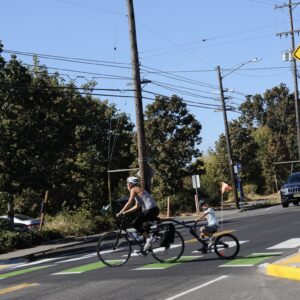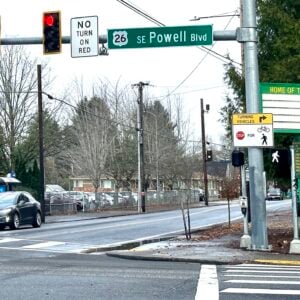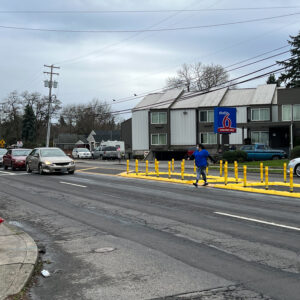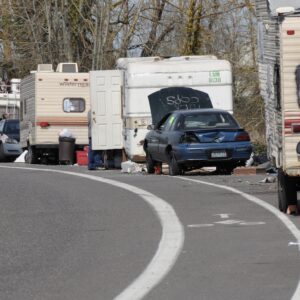(Photo from beacon manufacturer)
The Oregon Department of Transportation flipped the switch on a new crossing treatment on SW Barbur this morning. The location, south of SW Hamilton Street near Rasmussen Village, is just up the road from where Angela Burke was struck and then killed on December 15th, 2010 by Caleb Pruitt as he sped south on Barbur.
Burke was walking her bike, attempting to cross the street, when she was struck. Pruitt received a 60 month prison sentence in the case.

The location where the beacon was installed is a particularly high-speed section of Barbur. It has five auto lanes and bike lanes in both directions. A median island and pedestrian warning signs already exist due to a TriMet bus stop nearby (see photo). Activists have been pushing ODOT to install a crossing treatment in this location; but because Barbur is a state highway, ODOT was hesitant to do anything that could potentially impede auto traffic flow and/or cause rear-end collisions.
“ODOT has taken the unusual step of installing this flashing beacon above the highway to make it easier for drivers to see.”
— ODOT statement
However, perhaps due in part to the high-profile tragedy, ODOT made it happen.
In a statement yesterday, the agency referred to the installation of the beacon above a highway as, “an unusal step.” In addition to the flashing beacon, they’ve also installed additional warning beacons prior to the crossing to “warn drivers to slow down ahead of time so they can stop safely.”
The beacon itself is activated via a push button. When the LEDs are flashing, people using the road (in cars or on bikes) are legally obligated to wait until a person has crossed safely before they continue. In their press release, ODOT warns people who will use the beacon to, “always be alert for the driver not paying attention—and not stopping.”
Rapid flash beacons are a relatively new tool for traffic engineers. Portland has installed them in several other places, including an intersection on SE Foster that was the site of two fatalities in November 2010.
The beacons cost about $35,000 a piece.





Thanks for reading.
BikePortland has served this community with independent community journalism since 2005. We rely on subscriptions from readers like you to survive. Your financial support is vital in keeping this valuable resource alive and well.
Please subscribe today to strengthen and expand our work.
Thanks to ODOT and to neighborhood advocates who have worked to make this crucial safety improvement on Barbur. The WPC looks forward to advocating for more needed improvements along this corridor.
Thanks for all your work and helping to make this possible, Steph.
Roger Averbeck, Marianne Fitzgerald, and a number of other local advocates did a great deal of work to work with ODOT. WPC was their back-up singer to their rockstardom (as we should be).
Thank you, Rob, for giving us a few nudges when we needed it.
great. now they need to install about 10-15 of them on Foster now.
Drivers are required to stop when there’s a pedestrian in a crosswalk. Yet ODOT seems remarkably unconcerned about widespread noncompliance with the law. That needs to change.
Huh. “always be alert for the driver not paying attention- and not stopping”. So. This achieves what, exactly? If it’s not enforced then what is the point? Crossing here you MIGHT make it across?
Sometimes it’s not about drivers intentions but rather plain old visibility. I have seen many many pedestrians wearing dark clothing on a typical rainy day. It can be very difficult to see them, especially if the pedestrian comes out of the corner of someone’s wet windshield where the wipers don’t clean. No blame here, just facts.
I applaud these because they work. People really do slow down and stop. Pedestrians wait till people stop. Drivers have warning and can adjust their driving in plenty of time. Good for all concerned
My issue with the rapid flash beacons is that they take an unambiguous situation –ped in a crosswalk, driver required to stop –and make it into an ambiguous one.
The ORS says that “[w]hen a driver approaches a flashing yellow light used as a signal in a traffic control device or with a traffic sign, the driver may proceed through the intersection or past the signal only with caution.” (ORS 811.260(9))
But the law requires a driver to stop when there’s a pedestrian in a crosswalk, so the flashing yellow conveys an erroneous impression to drivers that they’re allowed to continue through if they think it’s safe enough. It encourages the problem we should be fixing.
And I know what the response is going to be: These beacons are better than nothing, because there’s SOME improvement in compliance. I agree, they’re better than nothing –but that’s not the issue. The effectiveness shouldn’t be as compared to doing nothing, it should be as compared to buying and installing a similar device at a similar cost.
A suggestion for what that similar device should be? The same thing but with a solid RED until the ped is safely across. No ambiguity, just as visible, same cost and (I bet) better compliance.
I agree… Rapid Flash beacons allways seemed like a ‘solution’ designed to allow as much auto throughput as possible. They increase yielding compliance for sure, which is great, but a full signal with a red-light is the most secure crossing option.
Even with the beacons it’s still unclear to me how this is technically a crosswalk. Can anyone point out the statute that would define this as such with or without flashing lights?
Keep in mind there are no on-street markings and the pedestrians are not obeying a signal. It’s unclear to me why ODOT doesn’t add striping.
Whether they are concerned or not I don’t know, but they aren’t responsible for enforcing laws.
Did I read that correctly? Somebody hit and killed a pedestrian and actually did jail time? I wonder if he would have gotten off with probation if she’d been riding her bike instead of walking it.
The driver was drunk. Had he merely been stupid he’d be a free man.
Stupid or distracted, or careless, etc, etc…
Drunk and stoned…
photo enforcement would reap a ton of money in these budget shortfall times….
Thanks for the article. Hope to see a lot more of these soon. If it was a matter of driver safety rather than pedestrian safety you have to wonder how much more commonplace these would be. Sad that it took a tragedy like Ms. Burke’s.
I agree with captainkarma, photo enforce these and use the money to purchase and install many more.
And a lot of it goes into evaluating the location. It’s not just a simple, “Durp…let’s put it here.”
Happy to see this come through.
This is great. I witnessed a car-pedestrian accident there on Jan 18th. I wonder if that had anything to do with it?
I agree with John Mulvey. The light should turn red. He brings up a good point, flashing yellow could be confusing. We should put a higher priority on safety.
In the title of this post, a more honest word than “fatality” would be “death.” Because that’s what it is. “Fatality” is the language of those who see these things as inevitable, as acts of god, as “fate.” And it’s also a euphemism. Designed to engage the cerebrum and blunt the visceral reaction that is appropriate when reading about or witnessing death. If any headway is to be made in taming streets like this, we can start by telling people the truth, fully and without filters, regarding exactly what kind of mechanized madness we’re involved with. She deserves that.
Just checked out your site. I need to join your organization. Thanks for the help!
There needs to be improvements to the cross walks just down the street from here at these two intersections.
1. Barber and SW Natio Parkway – I’ve seen the aftermath of accidents there (crinkled up cars). I don’t know how to safely ride my bike through this area, any ideas?
2. Barber and SW Lane – I use this on my commute home (I come up SW 1st to Barber – ride the sidewalk for roughly 1 block – then use this cross walk to cross the road and continue on Barber).
There is no reason not to improve these two cross walks.
I don’t like these beacons one bit. As others have pointed out, they give an ambiguous message, and false sense of security to a pedestrian. They just installed one a few blocks from my house in Bend, at a spot that gets almost zero ped traffic. I have not idea why it is there (on Hwy 20 near Pilot Butte). I am a pedestrian a lot, and know that the only time I am safe is when a car is stopped and I have eye contact with the driver. So, I just see these as very expensive crosswalks. The reason they are so ambiguous is that a driver could drive that route 50 times before an occasion then there is actually a pedestrian. The driver is not in a mindset to prepare to stop, or even be thinking about it. I know, because last week I drove through the one near my house, it was flashing, I was the only car that even slowed down, and there was no pedestrian (probably a prankster)
Observations RE the new crosswalk and rapid flashing beacon (RFB) at 4900 SW Barbur Blvd:
From 5:30 – 6:00 pm Wed. Feb. 8th, I observed 11 pedestrians and two bicyclists use the new crosswalk. As you would expect on this 5 lane arterial, vehicle traffic volumes were high.
Contrary to a previous post, there are new ladder style crosswalk pavement markings. My observation point was near the eastside (SB) transit stop, not near the crosswalk entrance (to avoid confusing any motorists).
Three of the pedestrians used the new beacon, 8 did not. I spoke with 4 of the peds who did not use the beacon – they knew about it but did not realize it was operational, as it has been under construction for several months. One ped mentioned they thought it was supposed to be a traffic signal (ie red light).
The bicyclist crossed Barbur twice – he initially did not use the beacon, but after I informed him that it was working, he used it the 2nd time. All of the above individuals appeared to coming from or going to the nearby apartment complexes – using the driveway entrance nearest to the new crosswalk.
RE motorist behavior, I observed one close call while the beacons where in operation. A ped was crossing east to west: the NB curb lane and middle lane had multiple vehicles stopped (as did all SB lanes). The ped was proceeding across (in the middle NB lane, in the crosswalk). A vehicle travelling at full speed in the left hand, inner most NB lane did not stop or even slow down, passed the que’s of stopped vehicles. Luckily the ped was paying attention and stopped just in time before entering the third lane.
I also observed some confusion among motorists that stayed stopped while the beacon was in operation, after the ped had cleared all three NB lanes and the median island. IE they may have thought it necessary to stay stopped until the beacon stopped flashing.
This situation caused several stopped NB vehicle drivers (including a TriMet Bus) in the que’s behind to blast their horns. Fewer issues developed for the SB lanes, but I did notice poor compliance with the advance stop bar in both directions. I suspect this was due to approaching vehicle speeds.
Lessons learned? Perhaps all modes will get used to the new facility, but it does seem that additional education efforts are needed in the short term. My point is it awesome to see ODOT installing new facilities – but education and enforcement are also needed…